Text and photos by Mary L. Peachin
Vol. 10 No. 11
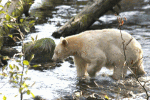 Clawing for spawning pink salmon along a river stream, the black bear sow busily fed her two cubs. Suddenly, lumbering along the opposite side of the creek, a rarely sighted White Spirit kermode approached. Expecting a typically protective sow to charge the male kermode, it was with excited anticipation that we waited for the action to begin. The cubs apparently didn’t have confidence in mom. Like a flash, they scrambled up the trunk of a red alder.
Clawing for spawning pink salmon along a river stream, the black bear sow busily fed her two cubs. Suddenly, lumbering along the opposite side of the creek, a rarely sighted White Spirit kermode approached. Expecting a typically protective sow to charge the male kermode, it was with excited anticipation that we waited for the action to begin. The cubs apparently didn’t have confidence in mom. Like a flash, they scrambled up the trunk of a red alder.
While many have never heard of the rare white Spirit Bear: a rare recessive gene sub-species of the black bear, we were fortunate to observe three in two days. An unknown number of Spirit Bears primarily inhabit Princess Royale Island in Northern British Columbia. It is thought that a total of eighty kermodes might inhabit this 600-square mile island and a small portion of the surrounding Great Bear Rainforest, but that number is only a guess-timate. Princess Royal Island and the Great Bear Rainforest, accessible only by boat or float plane, are so remote that few visit the area.
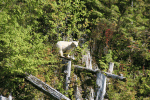 When the eight of us touched down in a DeHaviland Beaver, Tom Ellison, expedition leader, skipper and owner of the ketch, Ocean Light II, was feeling ecstatic. In his sixteen years of bear viewing and 30 years of coastal sailing experience, he had only seen a total of 18 kermodes. The previous day he’d experienced his best day of viewing; including his first sighting of a kermode cub. Our Prince Rupert departure had been delayed by fog for four hours and Ellison was bummed. “What’s really sad is that you’ve missed half a day.
When the eight of us touched down in a DeHaviland Beaver, Tom Ellison, expedition leader, skipper and owner of the ketch, Ocean Light II, was feeling ecstatic. In his sixteen years of bear viewing and 30 years of coastal sailing experience, he had only seen a total of 18 kermodes. The previous day he’d experienced his best day of viewing; including his first sighting of a kermode cub. Our Prince Rupert departure had been delayed by fog for four hours and Ellison was bummed. “What’s really sad is that you’ve missed half a day.
Eight of us had rolled out of bed at the Prince Rupert Eagle Bluff Bed and Breakfast, tossed down a quick breakfast then jumped into a cab to rush to the floatplane dock. After the long delay, we made the hour flight over stunning Coastal peaks and glacial lakes. The pilot glided the pontoons onto the water near the First Nations village of Hartley Bay.
After a quick zodiac transfer to the Ocean Light II, and listening to a brief safety talk, we weighed anchor to search for bears. An hour later, we motored close to an island. As we neared the shore in the ketch, we were astonished to see a creamy vanilla Spirit Bear standing on his haunches eating crab apples. After a brief retreat into the forest, we ogled him again. The experience was incredible instant gratification. Searching for kermodes the rest of the afternoon, a large stellar sea lion had to suffice. The sow and cub did not re-appear.
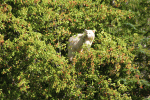 Tom boasted that Susan Cohen, a resident of Queen Charlotte Island, was the best cook around. And he wasn’t wrong. Dinner included fresh Coho salmon, spaghetti squash, salad with a miso dressing, boiled potatoes. And after dessert, Bishop Bay offered the best natural hot spring along the Inside Passage.
Tom boasted that Susan Cohen, a resident of Queen Charlotte Island, was the best cook around. And he wasn’t wrong. Dinner included fresh Coho salmon, spaghetti squash, salad with a miso dressing, boiled potatoes. And after dessert, Bishop Bay offered the best natural hot spring along the Inside Passage.
Other than a BC Ferry boat making its 18-hour run between Port Hardy and Prince Rupert, we had the Passage to ourselves. Crawling into sleeping bags in our bunks, we drifted off listening to the blow and tail slapping of humpback whales.
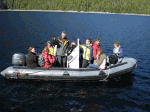 The next morning, we took the hard-bottom zodiac to a rocky landing on Gribbell Island. We hiked 1/2 mile through old growth and alder rainforest to one of two Gitga’at cedar-hewn bear stands along Riodan Inlet. Soon after our arrival, two black bears ambled down the stream. Lazily, they fished for spawning pink salmon. Richard, our Gitga’at guide explained that an abundant crop of salal had the bears alternated their feeding between the berries and the salmon. For the next four hours, we had to be content watching stellar jays, dippers, and dying salmon struggle their way up current.
The next morning, we took the hard-bottom zodiac to a rocky landing on Gribbell Island. We hiked 1/2 mile through old growth and alder rainforest to one of two Gitga’at cedar-hewn bear stands along Riodan Inlet. Soon after our arrival, two black bears ambled down the stream. Lazily, they fished for spawning pink salmon. Richard, our Gitga’at guide explained that an abundant crop of salal had the bears alternated their feeding between the berries and the salmon. For the next four hours, we had to be content watching stellar jays, dippers, and dying salmon struggle their way up current.
Then the bear viewing action picked up. Across the stream, a hungrier black bear aggressively chased salmon in the stream. After several unsuccessful lunges, he scored. Gripping the struggling salmon, he waded to the bank to consume every scrap and morsel. A less adept sub-adult clumsily belly flopped into the water. After grasping a salmon, he retreated into the forest to enjoy his catch. We had a quick, faraway glimpse of a kermode and several more black bear.
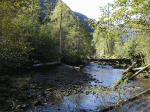 As the afternoon waned, the bear viewing escalated into an unbelievable scene. It was late afternoon when we watched the sow with two cubs approached by the kermode and the cubs sprint up the tree.
As the afternoon waned, the bear viewing escalated into an unbelievable scene. It was late afternoon when we watched the sow with two cubs approached by the kermode and the cubs sprint up the tree.
Two kermodes inhabit the area. Our Giga’at guide noted that this three year old kermode was making his first appearance near the viewing stand. Wondering why the bears didn’t react to one another, he explained that black bears tolerate one another better than grizzlies. If two males are going to fight, they wait until nightfall. The second kermode appeared briefly as we were leaving.
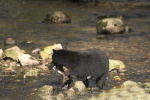 Nature’s spectacular show wasn’t over. As we saluted our day, a humpback, one of many feeding in Bishop bay, breached and finned continually. Three harbor seals watched both us and the whale until it gave a final tailing. As we enjoyed another delicious dinner accompanied by opera and classical music, we relived the day’s excitement.
Nature’s spectacular show wasn’t over. As we saluted our day, a humpback, one of many feeding in Bishop bay, breached and finned continually. Three harbor seals watched both us and the whale until it gave a final tailing. As we enjoyed another delicious dinner accompanied by opera and classical music, we relived the day’s excitement.
Traveling six hours south to explore some of British Columbia’s grizzly habitat, Ocean Light II‘s 71-foot mahogany and Douglas fir sailing ketch navigated the Inside Passage, the waterway used by large cruise ships heading to Alaska. It wasn’t just another “day at sea”. There were booming waterfalls spilling over granite cliffs, a view of Buteland’s abandoned salmon cannery, now a ghost town in disrepair. Migrating humpbacks and elephant seals shared this gorgeous landscape, while Dahl porpoises rode in the wake of our boat.
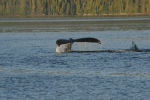 Tom gave us a briefing on grizzlies. “These bears are unpredictable.” He asked three members of the group to carry bear spray and reminded us to always stay close together. Unlike Gribbell Island, we would only eat in the inflatable and relieve ourselves in the water.
Tom gave us a briefing on grizzlies. “These bears are unpredictable.” He asked three members of the group to carry bear spray and reminded us to always stay close together. Unlike Gribbell Island, we would only eat in the inflatable and relieve ourselves in the water.
Wayne McCory, a noted bear biologist and a wildlife photographer was in Mussel Inlet when we arrived mid-afternoon. McCory had observed 16 bears during the day and had been charged by a sow protecting her cub. The fiord is part of the Great Bear Rainforest’s Fiordland Recreation Area, named for its dramatic glass-like granite glacial escarpment.
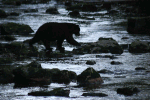 The area is spectacularly beautiful. The valley has steep granite cliffs lined with rainforest. The Inlet flows approximately three miles. Harbor seals fed in the bay, while enormous flocks of gulls, gorging on salmon eggs, lined the beaches at the mouth of the river. Discovered by explorer George Vancouver, Mussel Inlet was named for one of his men who became ill after eating the mussels. He died in nearby Poison Cove. Today, the area is managed by the Kitasoo nation who live in the village of Klemtu.
The area is spectacularly beautiful. The valley has steep granite cliffs lined with rainforest. The Inlet flows approximately three miles. Harbor seals fed in the bay, while enormous flocks of gulls, gorging on salmon eggs, lined the beaches at the mouth of the river. Discovered by explorer George Vancouver, Mussel Inlet was named for one of his men who became ill after eating the mussels. He died in nearby Poison Cove. Today, the area is managed by the Kitasoo nation who live in the village of Klemtu.
Wasting little time, the afternoon was spent observing four grizzlies including a pair of stunning blonde-faced twin sub-adults. When one of the males swam across the river, a black bear hightailed it when he saw the grizzly approaching.
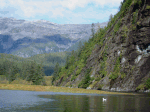 Tom announced that anyone wanting the opportunity to view a sow with a spring-born cub should be prepared to depart the Ocean Light II at first light—without breakfast! The inflatable pulled up to a shore where we scrambled over clumps of sedge grass dodging decaying salmon carcasses in the tidal flat. We waded across slippery algae-covered rocks perching on a hollowed log. It served as our viewing stand to watch the sow and cub.
Tom announced that anyone wanting the opportunity to view a sow with a spring-born cub should be prepared to depart the Ocean Light II at first light—without breakfast! The inflatable pulled up to a shore where we scrambled over clumps of sedge grass dodging decaying salmon carcasses in the tidal flat. We waded across slippery algae-covered rocks perching on a hollowed log. It served as our viewing stand to watch the sow and cub.
The cub’s appetite was hungry for crabapple, and he leaped like a chimpanzee from one tree to the other. When mom wandered back to the stream to catch salmon, the cub cried at her disappearance. Eventually, the sow responded to her baby’s cry, and returned. Being downwind, the cub couldn’t smell mom’s approach until she stood on her two hind legs nibbling at a few crabapples. Tom considered the viewing opportunity unique because sows typically do not expose their first year cubs. We were fortunate to spend several hours watching them.
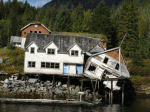 Bears dug under rocks exposed at low tide for salmon roe while others feasted on salmon or crabapples. Two sub-adults wrestle playfully. A dominant bear joined forces with two siblings chasing two bears up the side of a cliff. Trapped, one of the bears gave another a slobbery kiss, not the fight we had anticipated. During the day, we viewed 18 grizzlies, at one time surrounded by seven. We stayed huddled together as some bears approached within several dozen feet.
Bears dug under rocks exposed at low tide for salmon roe while others feasted on salmon or crabapples. Two sub-adults wrestle playfully. A dominant bear joined forces with two siblings chasing two bears up the side of a cliff. Trapped, one of the bears gave another a slobbery kiss, not the fight we had anticipated. During the day, we viewed 18 grizzlies, at one time surrounded by seven. We stayed huddled together as some bears approached within several dozen feet.
Four days of beautiful, sunny weather was an unexpected surprise. Brad Hill, a Calgary photographer, noted, when we awoke to rain our last day that it would be a “monochromatic” day. And so, we experienced grizzlies in the mist. Only when a bear approached slowly, Tom might talk saying, “it’s OK mom, stay gentle.” We backed away.
If you go:
Hawk Air provides air service from gateway city of Vancouver to Prince Rupert; www.hawkair.net or 800.487.1216
Pacific Coastal Air flies the return from Bella Bella; www.pacific-coastal.com or 888.663.2872
Inland Air has floatplane service from Poison Cove to Bella Bella; www.inlandair.bc.ca or [email protected] 250.624.2577
Overnight in Prince Rupert Eagle; Bluff Bed and Breakfast, 201 Cow Bay Rd, 800-833-1550 or 250-627-4955
Ocean Light II‘s remodeled interior includes five double berth cabins sharing two heads and a facet shower. Below deck, a salon seats twelve. There are no hotel-type amenities. This is an adventure requiring good physical and mental shape and a mind set expecting a flexible itinerary. Days are long and filled with activity, including hiking on uneven and wet and slippery terrain. Weather conditions can be variable and be prepared for changing weather including torrential rain, and cold temperatures. Don’t forget to bring rain gear, high rubber boots, bug repellant, and sunscreen.King Pacific Lodge, one of British Columbia’s most luxurious resorts, offers day trips to guests to view the kermodes. www.kingpacificlodge.com
